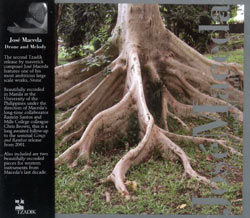
Though not generally well known in the West, Jose Maceda's work was and is revered in his native Philippines and throughout Asia. Beginning with a career as a concert pianist in the 1930's, Maceda opted to study ethnomusicology, and eventually became a professor in Manila. His field recordings comprise a vast collection of native Philippino music and language, and he wrote extensively about them. The influence of this work shows very clearly in the compositions he started writing in the 1960's, when Maceda was in his 50's. His first works called for very large ensembles utilizing native Philippine instruments (bamboo, gongs etc) and voices, building dense layers of overlapping sound fields. Maceda spoke of a "blurring effect" that he hoped to achieve.
That blurring effect is in evidence in the pieces collected on Drone and Melody, but here Maceda wrote for western instruments, sometimes mixed in with traditional Philippino sounds. "Strata" begins with characteristic choruses of buzzers and bamboo, which are soon adjoined by flutes (of the orchestral variety), playing repeating patterns in loose unison. A fog of rhythm, tone and melodic fragments, the piece becomes denser with the inclusion of cellos and guitars, also playing repeating figures, underpinned with dark gongs. All of the melodies play around, or rather on top of each other, creating a mass of dense filigree. When periodic rhythm is introduced, it is of the simplest variety, a slow ragged pulse pushing through the mass. Maceda wanted to unhinge the western instruments from their usual functions and make them adhere to his new sound world, and I think he succeeds admirably with this work. It makes me wonder if he wrote for larger western ensembles.
"Sujeichon" is a piece for four pianos based on Korean court music from around 700 A.D. A similar blurring effect is heard here, but sparser and less varied in its tonal color. The piano lines separate and converge around a drum part played in the low register.
The final piece on the disc, "Music For Two Pianos and Four Percussion Groups", sits somewhere between the first two works density-wise. The instruments play independently of each other, collecting in brief choruses and then spinning out away from each other. Rhythms start and stop, joined by contrasting voices. It certainly seems that Maceda used a lot of variety within his chosen aesthetic, and i hope that much more of his work is released in future.
Comments and Feedback:
|



